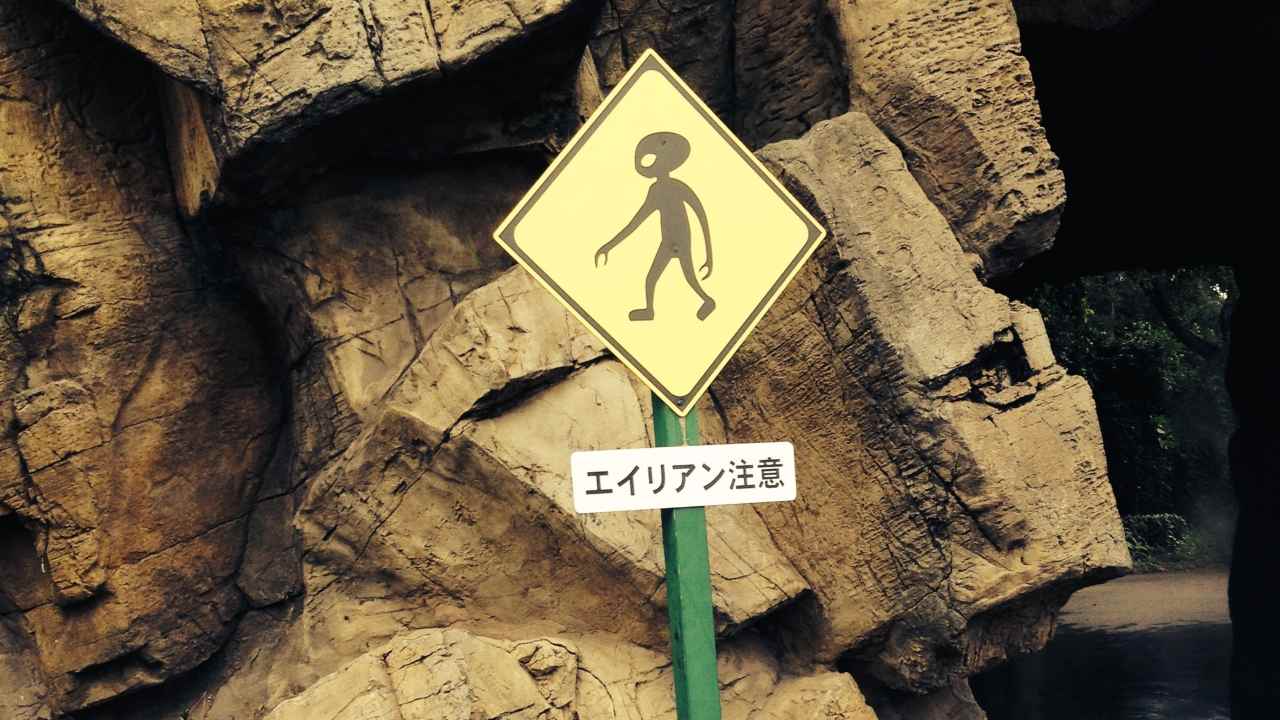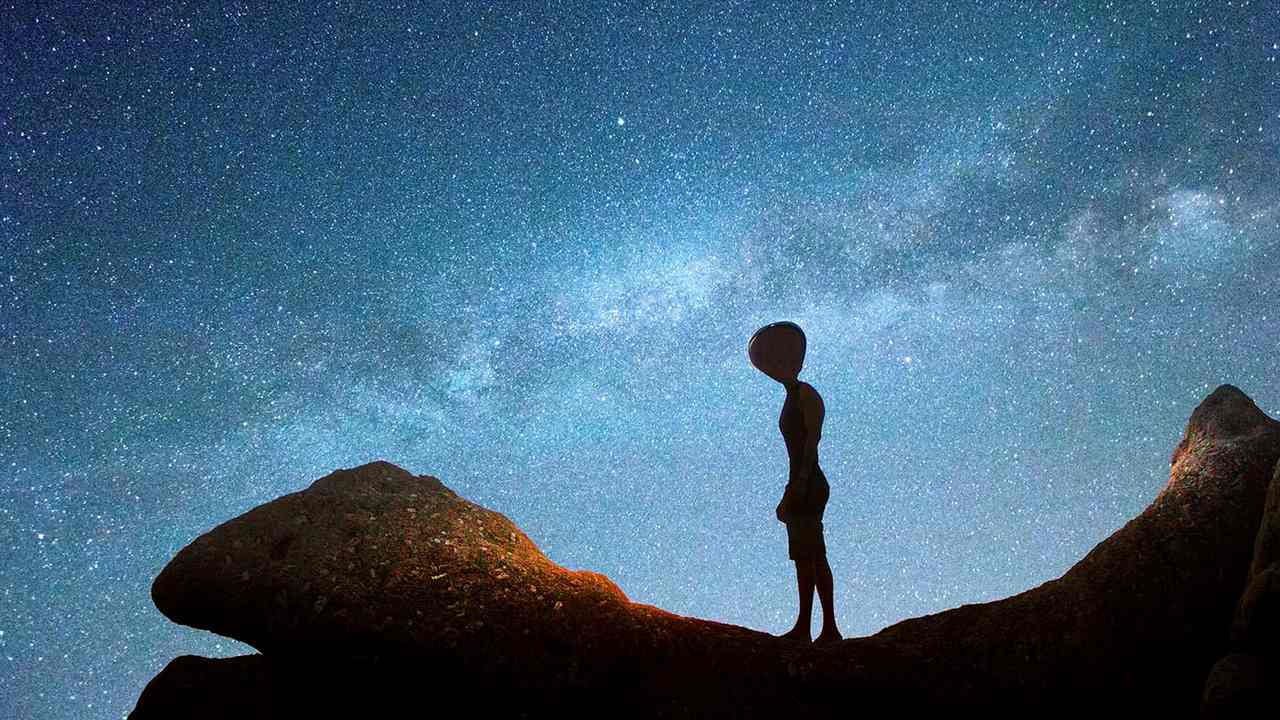Siddharth PandeyFeb 28, 2021 11:14:10 IST
For more than a century, our imagination has fuelled our search for aliens. We have envisioned them as giant robots, little green men, or slimy creatures. After the two World Wars, humanity’s technological progress sky-rocketed, quite literally, opening a new horizon for exploration: space. It was time to move beyond gazing upwards – our rockets could take orbiters, rovers and eventually, people, to worlds that could, or may be, harbouring life. The stage was set for our encounters with aliens to take place. Our machines have been landing on Mars, flying past all the planets in our solar system, and observing the stars and planets in deep space for over 45 years now. Even with all this progress, our guess as to whether aliens exist is as good as it was a century ago.

A signpost reads “Beware of aliens” at Space World in Kitakyusyu, Japan. Image Credit: Ai Takeda/Unsplash
In the 1950s, over a casual lunch conversation, a scientist called Fermi brought up the high likelihood for Earth-like life to exist in the Universe with the innumerable number of stars and planets in the Universe, and the simultaneous lack of evidence to support it. Coined the Fermi paradox, this inconsistency something that motivated (and demotivated) communicators to think about Aliens for the years to come. In 2017, a travelling piece of space rubble was spotted from 85 times the Earth-Moon distance away. For its unusual characteristics, the object known as ‘Oumuamua became a sensation. It’s size, wobble and acceleration were unusual for interstellar objects – hard to explain by conventional standards. A popular recent hypothesis regarding it being a product of an alien construct, led by Harvard professor Avi Loeb, was widely shared in the international media. It was generally shot down by the scientific community as “insufficient evidence to support such a premise”, since science demands hard, incontrovertible proof, even if the process to get to it is cumbersome.

An illustration of ‘Oumuamua, the first object we’ve ever seen pass through our own solar system that has interstellar origins. Image credit: European Southern Observatory/M. Kornmesser
So why are aliens so hard to find?
Space is vast. It takes years to build missions, launch them, and travel to worlds that appear promising. Space is also risky, and getting a spacecraft to enter the right orbit around a planet or land safely on its surface is a complex business to which tens of missions have been lost over the decades. On arriving, the search for ancient relics or by-products of simple microbial life is priority. The information at these nascent stages of exploration is hard to decipher, and often leaves plenty of room for speculation and doubt. We are getting better at unravelling these clues with experience, but reaching the limits of what is possible with the instruments at hand. Fitted on low-powered, small, automatic rovers that are millions of kilometers away from us, the scope of exploration is fairly limited. For the moment, our best bet is returning samples from these worlds back to us, to study on Earth.
With the Perseverance (Percy) rover, which made a safe landing on 18 February, NASA is aiming to inch us forward by returning samples from our near neighbour Mars. The SUV-sized rover packs a drill on its back and a helicopter under its belly, designed to drive around its landing site in Jezero Crater. The crater was once home to a lake that had dramatic streams filling up its floor – an exciting place to look for traces or deposits of biological activity. Shortly after the landing, we gorged on never-before-seen footage of a rover landing on the surface of Mars, kicking up dust in the process. As it settled, the panoramic photos of the surrounding environment show the arena that could perhaps finally ascertain if Mars once had life.
Also read: Stunning 360-degree panorama captured by Perseverance of its Mars landing site
We are still unsure what to expect. Would life on Mars be like that on Earth? Or are we about to uncover a completely new form of life? If we did, would it be a simple or complex life form? We know that the complexity of life on Earth arose from the long periods of habitable conditions on Earth. Was it the same on Mars? Does life evolve differently on different planets? Zoologist & astrobiologist Arik Kershenbaum at Cambridge University studies vocal communication of wolves and dolphins. He offers an interesting view on understanding the process of life, explaining that there is much to learn from animals on Earth, to help determine the different characteristics of extraterrestrial life motion, communication, socialising, intelligence, etc. Most studies of extraterrestrial life is based on simple microbial life – their cell structures, their metabolism, preferences for certain environments, etc.
“Problems like finding food, avoiding becoming someone else’s food, and reproducing. These Earthly problems are also problems that need to be solved on alien worlds,” Kershenbaum writes in a story for BBC’s Science Focus magazine.
So the search is on, both at the micro level, looking at how simple life on Earth deals with harsh environments, as well as macro, looking at giant suns in deep space and their planets where statistically-likely alien life awaits. Just in the last 50 years, we have discovered the wealth of life teeming on Earth in the most unexpected dark, deep, dry, wet, cold and toxic of places. This has motivated us to look far and wide – from clouds in the thick Venusian atmosphere, to subsurface water columns on Mars; from liquid methane rivers on Titan, to underwater hydrothermal vents on Europa or Enceladus.
The scientific community is divided on their understanding of the origin of life on Earth. Some talk about black smokers, or hydrothermal vents at the bottom of frigid cold oceans, teeming with simple and complex life. Recent evidence from the ancient outback of Australia points towards a more terrestrial origin, on beaches and terrestrial hot springs. Natural environments offer analogue scenarios for scientists to test their experiment plans and for engineers to train their instruments before they are packed up and flown to space. In India, Ladakh offers a unique cold, high altitude environment with glacial pools, salt-water lakes, hot springs and frozen soils – an excellent Mars analogue, only recently being recognized, after international expeditions since August 2016 to the region.
Astrobiology as a field attracts people from all walks of life, professions, ages, and regions: for many this is the crux of their excitement about space and its exploration. It humbles us, inspires us and awakens us from our usually monotonous Earthly troubles, makes us strain our short-sightedness and self-centred tendencies. So do we know when will we meet aliens? No. Does this excite us or bore us? Will we ever be able to find an answer? With the increasing popularity of the subject, more minds will hopefully get to task and help us answer this question for once and for all.
From 2021, a five-month Earth and Space Exploration Program, led by Amity University Mumbai for students, teachers and travellers that want to explore the terrain in Ladakh in an expedition led by leading astrobiologists and earth scientists. The program is a great pathway for students to pursue an exciting career in Earth and Space Sciences, and for space enthusiasts to get a taste of the not-so-distant future, when space exploration is open to civilians as the scientists and engineers in the space race.
The author is the Head of Amity University’s Centre of Excellence in Astrobiology. He tweets at @siddharthpandey.










